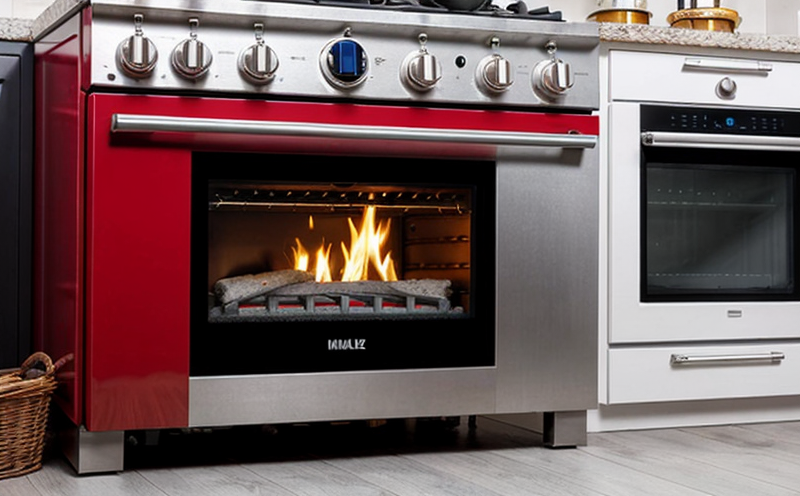IEC 60695-2-12 Glow-Wire Ignition Test for Plastic Parts
The IEC 60695-2-12 Glow-Wire Ignition (GWI) test is a critical procedure used to evaluate the flammability of plastic parts in household appliances. This standard, published by the International Electrotechnical Commission (IEC), is designed to ensure that electrical and electronic products do not pose fire hazards due to their material composition.
The Glow-Wire Ignition test involves subjecting a specimen made from the plastic part under evaluation to controlled heating using an electrically heated tungsten wire. The temperature of this wire can be adjusted according to specific test conditions, typically ranging between 450°C and 850°C. When the plastic part comes into contact with the glowing wire, it is ignited if its ignition behavior meets predefined criteria.
This testing method is particularly important for household appliances such as microwave ovens, washing machines, and dryers where high temperatures are common during operation. By ensuring that these parts do not ignite under these conditions, manufacturers can significantly reduce the risk of fire incidents in end-user environments.
The test setup consists of a small wire that glows when electrically heated. The wire is placed close to the sample part and then brought into contact with it. If the part ignites after being exposed to the glowing wire for a specified duration, this indicates poor flame retardancy properties of the material used.
For accurate results, careful specimen preparation is essential. This includes selecting appropriate samples that represent typical usage conditions in appliances. Samples should be cut from actual parts rather than just thin sections or small pieces since they may behave differently when exposed to heat stress.
The IEC 60695-2-12 specifies various temperature levels for the glowing wire, depending on whether the test is conducted at low voltage (LV), medium voltage (MV), or high voltage (HV). These different settings account for variations in electrical insulation ratings within appliances.
Testing laboratories must adhere strictly to IEC 60695-2-12 guidelines during every phase of the process, from sample preparation through to final analysis. Compliance officers and quality managers rely heavily on these tests to ensure products meet regulatory requirements and industry standards.
In summary, the Glow-Wire Ignition test plays a crucial role in safeguarding consumer safety by preventing potentially dangerous situations associated with flammable materials in household appliances.
Applied Standards
The IEC 60695-2-12 Glow-Wire Ignition Test is widely adopted across various industries, particularly those involving electrical and electronic equipment. Some key standards that incorporate this test include:
- IEC 60730 Part 1: General Requirements for Standby and Off-Mode Power Consumption and Related Tests
- IEC 62368-1: Safety of Information Technology Equipment
- EN 60950-1: Safety of Information Technology Equipment (European equivalent)
The Glow-Wire Ignition test is essential for ensuring compliance with these standards, which focus on reducing the risk of fires caused by electrical components and materials used in consumer electronics.
Benefits
Implementing the IEC 60695-2-12 Glow-Wire Ignition Test offers numerous advantages for manufacturers, quality managers, and compliance officers:
- Enhanced Safety: By identifying flammable plastics early in the development process, companies can redesign their products to use safer materials.
- Compliance Assurance: Ensuring that all components comply with relevant IEC and national standards helps avoid costly product recalls and fines.
- Risk Management: Identifying potential fire hazards allows manufacturers to implement corrective actions before they become actual problems in the market.
- Consumer Trust: Demonstrating a commitment to safety fosters trust among consumers, leading to increased brand loyalty and sales.
In addition, adherence to this test can help companies stay ahead of emerging regulations and industry trends related to fire safety in electrical products.
Quality and Reliability Assurance
The IEC 60695-2-12 Glow-Wire Ignition Test is part of a broader quality assurance framework aimed at maintaining consistent product performance across batches. This section highlights some critical aspects:
- Consistent Sample Preparation: Ensuring that all samples are cut from actual parts rather than thin sections guarantees accurate representation.
- Standardized Temperature Settings: The use of specific temperature levels ensures uniformity in testing across different laboratories and regions.
- Replicate Test Conditions: Mimicking real-world operating conditions helps identify any potential issues early on during the design phase.
Regular calibration of test equipment is also crucial to maintaining accuracy over time. This includes checking both the glowing wire and other components of the setup for consistent performance.





